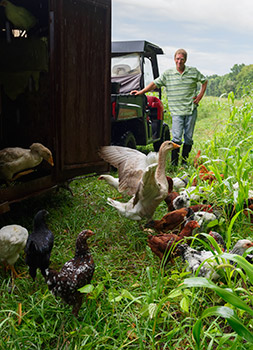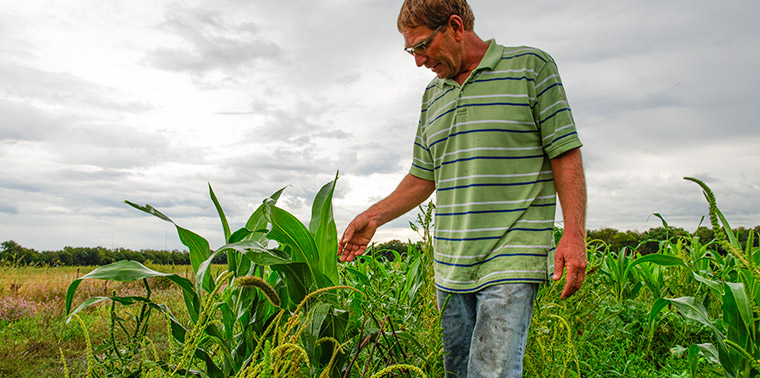December 5, 2016 — Editor’s note: This story was produced in collaboration with the Food & Environment Reporting Network, a non-profit investigative news organization.
In 2012, Gail Fuller’s 2,000-acre farm was at ground zero for the drought that decimated corn production throughout the Midwest. His corn and soybeans had barely squeaked through the previous dry summer, even as many of his neighbors in Lyon County, Kansas, saw their crops desiccate and fail in the unrelenting sun. But when the drought persisted into 2012, Fuller joined the ranks of farmers who told the companies that administered their federally funded crop insurance they needed compensation for ruined acres.
On a hot day in early August, the company’s adjuster and his boss arrived to inspect Fuller’s land. Fuller and the adjuster greeted each other warmly — they had gone to high school together and the adjuster used to work for Fuller, spraying pesticides on his land. But Fuller grew uneasy when he saw the two men lingering over remnants of turnips and other brassicas he had grown to keep the soil healthy in between regular crops. Fuller had tried to kill off these cover crops before planting his market crop, as crop insurance rules require, but high winds interfered with the herbicide application and some of them survived. He feared the insurance company might not honor his claim because of restrictions the federal crop insurance program places on the use of cover crops.
Sure enough, the insurance company withheld a six-figure payout and canceled coverage on some of his fields. Stunned and panicked, Fuller called his partner, Lynette Miller, and blurted, “I’ve lost my insurance!”
The denial of Fuller’s claim and loss of insurance was seen not just as a personal blow, but as a signal that Earth-friendly farm practices can come with unaffordable price tags.Word started to spread across the county and even across the country, at conferences and via farming publications and talk shows. The recipient of numerous farming awards, including one of the American Soybean Association’s 2013 National Conservation Legacy Awards, Fuller is a leading practitioner of what is often called regenerative agriculture or agroecology, in which farmers try to produce food and fiber in harmony with nature. They pay close attention to the health of their soil and the entire farm ecosystem. They often eschew tilling because it disturbs the complex, soil-enriching community of microorganisms in the soil. They increase their farm’s biodiversity by reintroducing livestock to their land. Some reduce or eliminate chemical fertilizers and pesticides and avoid genetically modified crops. They also — and this was Fuller’s downfall — embrace cover crops, plants grown not for profit but to prevent erosion, build organic matter and carbon in the soil, and support the complex underground symbiosis of plants and microbes. The denial of Fuller’s claim and loss of insurance was seen not just as a personal blow, but as a signal that Earth-friendly farm practices can come with unaffordable price tags, potentially discouraging their adoption.
Enriching Epiphany
When Fuller was growing up in the 1960s, his family’s farm had seven cash crops plus cattle, pigs and chickens. In the 1970s, the operation doubled in size, partially with rented acres, and began moving along with the mainstream to corn, soybeans and feedlot cattle. Fuller left his family’s operation and started his own farm in 1981. By the mid 1990s, he managed a combination of 3,200 owned and rented acres, mostly corn and soybeans, and enjoyed good yields.
Despite his success, Fuller began to grow disturbed by the environmental damage conventional farming practices were causing. His concern turned into outright alarm when a flood ripped the topsoil from one of his recently tilled fields in the mid-1990s. He immediately transitioned to no-till farming. Four years later he started planting cover crops, which he’d learned about at a farming conference called No Till on the Plains.

On Gail Fuller’s farm, cover crops nurture soil microorganisms, add valuable biodiversity to the landscape and provide food for grazing animals after the cash crop — in this case, sunflower — is harvested. Photo by Dave Leiker.
Fuller was far from alone. Across the U.S., farmers were talking about new practices that could transform agriculture from an assault on nature to an endeavor that supported and even enriched the land and so, ultimately, their own well-being and the long-term prospects for their operations. Many were conventional farmers who had concluded that the heavy tilling equipment, the fertilizers and pesticides, and the expensive GMO seeds of industrial agriculture were not only draining them financially but also combining to sap their land of resilience and make it even more susceptible to the vagaries of weather.
Ray Archuleta helped turn those inklings into a movement. A small diversified farmer in Missouri, Archuleta is a 33-year employee of the USDA’s Natural Resources Conservation Service, a federal agency that works with farmers to protect natural resources on private lands. About the same time Fuller was experiencing his epiphany, Archuleta was becoming frustrated with his work.
“We were spending all this money, but why weren’t the farmers’ lives improving?” he says. “Why weren’t they able to bring their sons into the operation? Why did they have jobs in town? I couldn’t put my finger on it.”
In the mid-1990s Archuleta started meeting a handful of farmers who were doing things differently. One was a North Carolina no-till farmer named Raymond Styer who used no fertilizer and had been planting cover crops for 40 years. “He had very few weed issues and amazing soils,” Archuleta says. “The only erosion he had was me, because I’d take boxes of his soil to show to farmers all over the country. The organic matter in the nearby forests was around 3 percent, but his soil was as high as 6 percent.”
Archuleta was instrumental in pushing NRCS to launch a massive soil health campaign in 2012. Critics charged that the NRCS was offering farmers advice that was not backed by research. But when it came to cover crops, NRCS could easily point to data generated by the University of Maryland soil scientist Ray Weil, co-author of the textbook The Nature and Property of Soils.
“Cover crops are an attempt to make the system more perennial. They capture the sun’s energy during the rest of the year and put it into the soil food web. They can more than double carbon inputs into the soil.” – Ray WeilIn the 1990s, Weil started asking mid-Atlantic farmers about the problem areas in their fields, trying to figure out what factors these areas had in common. He and his graduate student Joel Gruver, discovered that the problem areas suffered from the same malady: low levels of organic matter.
The solution was to build it up again, but how? Weil didn’t think trucking in loads of compost or manure would work on a large scale. Plus, moving these sources of organic matter to one farm meant losing them from another. Instead, he wanted to figure out a way to create organic matter on site.
On a typical farm, fields lay bare for most of the year. Most no-till farmers let crop residue decompose in the field, but even that isn’t enough to bump up soil organic matter in a significant way. What if, Weil thought, farmers sowed plants specifically to build organic matter during those down months?
“Cover crops are an attempt to make the system more perennial,” says Weil. “They capture the sun’s energy during the rest of the year and put it into the soil food web. They can more than double carbon inputs into the soil.”
And that’s just the beginning. Cover crops feed soil microorganisms so they can, in turn, deliver more nutrients to the cash crop. They also improve soil structure so water can penetrate to plant roots and create a mulch on the surface that slows evaporation. Cover crops also hold soil nutrients, like nitrogen, in place, instead of letting rain and snow wash them into waterways, where they become pollutants.

Beneficial insects abound on Gail Fuller’s farm, thanks to the variety of vegetation found there. Photo by Dave Leiker.
Leading practitioners also claim financial, not just environmental, gains for adopting cover cropping and other regenerative farming approaches: Their production per acre often exceeds their county average, while they realize savings on chemicals, seeds and fuel. And a recent survey from Purdue University’s Conservation Technology Information Center showed that corn and soybean yields increase year after year with cover crop use. “My biggest expense these days is caps,” jokes North Dakota farmer Gabe Brown, who uses cover crops. “The ag companies don’t hand them out to me anymore.”
Array of Obstacles
These grand claims, though, raise a compelling question: If there are so many benefits to regenerative farming, why don’t more U.S. farmers do it?
Fuller’s experience hints at the answer: an array of obstacles that keep them from making the switch. Land-grant universities favor conventional farming, so research and education that could boost acceptance of the regenerative approach get relatively short shrift. Land ownership is also a barrier; 39 percent of all U.S. farmland is rented or leased, and 80 percent of those acres are owned by people who don’t farm themselves and often have no interest in innovation they think might interfere with their rent checks. Peer pressure to plant and plow in lockstep with the neighbors can also make change difficult.
Unfortunately for farmers like Fuller, crop insurance and cover crops have a hard time getting along. And then there’s the roadblock Fuller encountered: the Federal Crop Insurance Corporation, a taxpayer-funded insurance program managed by the U.S. Department of Agriculture’s Risk Management Agency and administered by a network of private companies. Most U.S. farmers who grow corn, soybeans, wheat, cotton and other commodities buy crop insurance through one of these RMA-supported companies. The insurance helps them ride out the vagaries of weather, market price and other variables, and helps farmers qualify for bank loans to cover the expenses of the growing season.
“It’s a must for a farmer to have crop insurance,” says John Evans, president of the Farmers State Bank in Aliceville, Kansas. “It’s all one hell of a risk when you get into agriculture.”
Unfortunately for farmers like Fuller, crop insurance and cover crops have a hard time getting along. In fact, in a 2015 National Wildlife Federation survey, 45 percent of 250 farmers who reported they were interested in trying cover crops but held back said they were concerned about potential complications with crop insurance. And over one-third reported that they’d been told by an agent or adjustor that using cover crops could put a claim at risk of denial. According to the latest U.S. Census of Agriculture, cover crops are planted on only 2.6 percent of the nation’s croplands, despite their many benefits. Certainly, anxiety over problems with crop insurance is one of the factors holding farmers back.
What is the crop insurance industry’s antipathy to cover crops? The RMA declined to be interviewed about Fuller’s case, cover crops or other regenerative practices, but an agency spokesperson emailed this statement: “RMA continues to be actively engaged with various stakeholders in the crop insurance program regarding many practices that are being utilized by farmers. This includes practices to enhance conservation, and practices that may be considered to be or supplement regenerative or agroecological practices, such as cover crops. In general, as long as a practice does not impact expected yields or conflict with the insurability requirements of the applicable crop policy and meets the definition of a Good Farming Practice, then a producer’s crop insurance policy should not prohibit the use of these practices.”
No one disputes that the RMA has to be careful with taxpayer money, but proponents of regenerative agriculture argue that many of the agency’s rules are based on outdated research. Ken Ackerman, an attorney, D.C. lobbyist for a variety of groups related to agriculture, and former RMA administrator, says the RMA has to be very conservative because of the massive amount of taxpayer dollars involved. “Its policies incorporate some very large handbooks on loss adjustment and farming practices that create requirements farmers have to follow,” he says. “If you don’t follow the requirements, the system can be very strict. Good research can make the agency change its ways, but they do need the research. And good farming practices are a moving target — what was a good practice today may be different from two years ago.”
No one disputes that the RMA has to be careful with taxpayer money, but proponents of regenerative agriculture argue that many of the agency’s rules are based on outdated research. In a 2014 opinion piece at Agri-Pulse Communications, Ryan Stockwell, a third-generation Wisconsin farmer who is also senior agriculture program manager for NWF, pointed out that the RMA manages practices like cover cropping so intensely that farmers are discouraged from using them, but it doesn’t apply the same level of management to other practices. In fact, Stockwell claimed in the piece that the agency allows at least 74 practices that might harm annual and long-term yields. For example, the RMA allows farmers to remove soybean crop residue and use it for animal bedding instead of leaving it on the soil to decompose, feed the soil microorganisms and protect against erosion, even though research shows that removing the residue reduces yield in the long run.
“Generally, crop insurance has not figured out how to deal with practices that pose a long-term risk to yield as well as long-term degradation of land and soil,” Stockwell says.

Now that he no longer has to follow strict rules about cover crops, Fuller is able to experiment with a variety of plant mixes to see what combinations do the best job of keeping his land healthy while providing an income, too. Photo by Dave Leiker.
In Fuller’s case, the insurance company used the RMA rule against “interplanting” — a practice in which cover crops are grown alongside the market crop during part or all of the growing season — to deny his claim. But interplanting was not Fuller’s intention. The nonmarket crops were only present because high winds had prevented him from terminating them with herbicide before he planted his market crop.
Back in Business
After Fuller’s insurance agency turned down his claim, NWF, which champions the use of cover crops on working lands for its benefit to wildlife, stepped in to defend him. Stockwell helped assemble a case to reverse the insurance company’s decision, beginning with a request that RMA clarify its rule about interplanting. The RMA responded with an elaboration that clarified the rule in Fuller’s favor. Simply put, insurance companies can’t call cover-crop use interplanting if bad weather interferes with the farmer’s ability to terminate it.
When the case reached arbitration in 2014, the judge ruled in Fuller’s favor and he got his payment. Regenerative agriculture got a reward out of the deal, too: The clarification made it a little easier for farmers all over the country to try cover crops. Now, Stockwell says, crop insurance companies have a harder time blaming weather-related yield failures on cover crops and a harder time denying claims by farmers who use them.
All is still not roses for Fuller. He lost his line of credit at his bank. Some of his landlords canceled his leases because of his unorthodox farming and because his falling out with the bank and the insurance company made them leery of losing rent. And in 2014, the insurance company denied yet another claim on account of cover crops, albeit a much smaller one, leading Fuller, who by now was fed up with the system, to stop buying crop insurance altogether.

Chickens and other farm animals take turns grazing and fertilizing Fuller’s fields. Photo by Dave Leiker.
Nevertheless, he is still in business on a farm much like the diversified model of his childhood — 800 rented acres with seven cash crops and cover-crop mixes that include up to 70 varieties of plants, each mix selected to tweak a specific improvement. Deep-rooted okra, for instance, is breaking up deep compaction in the soil. And his 70 cattle, 65 sheep, 800 chickens and 50 ducks all take a turn grazing and fertilizing his fields. In place of the canceled insurance, the overall resilience of his land protects him against extreme weather and a greater diversity of farm enterprises combine to supply his income.
In addition to keeping the farm healthy and whole, Fuller and Miller are encouraging others to give regenerative agriculture a try. Last spring, they held a two-day field school on the farm that drew 80 participants, from conventional farmers to scrappy permaculturists to government conservationists. They also convinced neighbor Terry Turner, who grows grapes for wine, to apply regenerative techniques to his viticulture. Now Turner, a retired firefighter, protects the soil with cover crops, and Miller grazes the sheep through the vineyard twice a year, where they nibble only the smaller plants that Turner used to kill with herbicide, not the vines, and deposit valuable manure along the way. Turner uses minimal agricultural chemicals and produces a crop on about US$200 less per acre than he used to spend, with yields that are as good or better than before.
At a recent harvest, Fuller and Turner gathered in a backyard shed with friends who had volunteered to pick grapes. They were exhausted — the vineyard had yielded roughly twice as much fruit this year as last. Turner served a tasty port, sucking it out of a barrel with a turkey baster and squirting it into plastic cups. “No one believes how well this is working,” he crowed. “I’m tweeting back and forth with a researcher at Cornell, and my results are better than hers.”
Fuller clinked his cup with Turner’s and beamed. ![]()
UPDATED 12.06.2016: The captions and Raymond Styer’s location were updated.
Ensia shares solutions-focused stories free of charge through our online magazine and partner media. That means audiences around the world have ready access to stories that can — and do — help them shape a better future. If you value our work, please show your support today.
Yes, I'll support Ensia!
